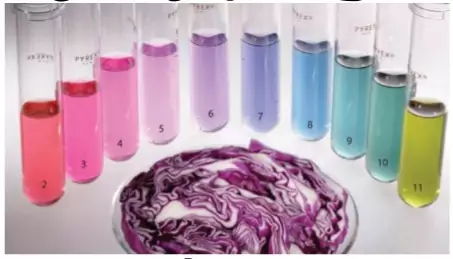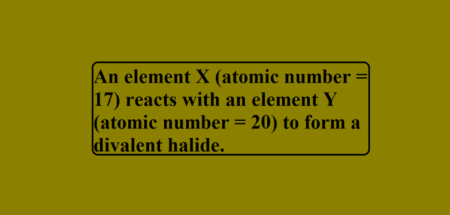Acid-Base Indicators and pH
(1) STRENGTH OF ACID OR BASE SOLUTIONS:
A scale for measuring hydrogen ion concentration in a solution, called pH scale has been developed. The p in pH stands for ‘potenz’ in German, meaning power.
p = potential or Power H = Hydrogen
(i) pH of a solution: pH of a solution is the negative logarithm to the base 10 of the hydrogen ion concentration expressed in mole per litre. pH = –log10 (H+).
| pH = 7 | Neutral Solution | H3O+ = OH – |
| pH > 7 | Basic Solution | H3O+ < OH – |
| pH< 7 | Acidic Solution | H3O+ > OH – |
| The range of pH is from 1 to 14 | ||
(ii) Detecting an Acid or a Base: We use litmus solution, phenolphthalein or methyl orange for this purpose. The colour change that they show in acidic and basic solutions are:
| Neutral | Acid | Base | |
| Litmus solution | Purple | Red | Blue |
| Phenolphthalein | Colourless | No change | Pink |
| Methyl orange | Orange | Red | Yellow |
We can also measure the strength of an acid or a base using a pH scale, which looks something like this:

Acid-Base Indicators and pH
(iii) pH Sensitivity of Plants & Animals:
- The human body works in a narrow range of pH 7 to 7.8. Acidity can be lethal for plants and animals.
- the pH of the Digestive System: The stomach secretes HCl to kill bacteria in the food. The inner lining of the stomach protects vital cells from this acidic pH.
- pH and Tooth Decay: Lower pH because sour food and sweet food can cause tooth decay. The pH of the mouth should always be more than 5.5.
- pH as self Defence Mechanism in Plants & Animals: Certain animals like bee and plants like nettle secrete highly acidic substance for self-defence.
- Acid Rain: If the pH of rain is lower than 5.6 we term it ‘acid rain’. This water, when flows in water bodies, makes the water acidic and difficult for aquatic organisms to survive. It also causes harm to monuments like the Taj Mahal.
Acid-Base Indicators and pH
(2) INDICATOR: Substances which show the acidic or basic behaviour of other substance by a change in colour are known as the indicator.
(i) Type of Indicator: There are many types of indicators. Some common types of indicators are
Natural Indicator, Olfactory Indicator, Synthetic Indicator, Universal Indicator
(a) Natural Indicator: Indicators obtained from natural sources are called natural indicators. Litmus, turmeric, red cabbage, China rose, etc. are some common natural indicators used widely to show the acidic or basic character of substances. For Eg.
- Litmus – Litmus is obtained from lichens. The solution of litmus is purple in colour. Litmus paper comes in two colour – blue and red.
An acid turns blue litmus paper red.
A base turns red litmus paper blue.
- Turmeric: Turmeric is another natural indicator. Turmeric is yellow in colour. Turmeric solution or paper turns reddish brown with base. Turmeric does not change colour with acid.

- Red Cabbage: The juice of red cabbage is originally purple in colour. Juice of red cabbage turns reddish with acid and turns greenish with base.
(b) Olfactory Indicator: Substances which change their smell when mixed with acid or base are known as olfactory indicators. For example, onion, vanilla, clove, etc.
- Onion: Paste or juice of onion loses its smell when added with base. It does not change its smell with acid.
- Vanilla: The smell of vanilla vanishes with base, but its smell does not vanish with acid. Olfactory indicators are used to ensure the participation of visually impaired students in the laboratory.

(c) Synthetic Indicator: Indicators that are synthesized in the laboratory are known as synthetic indicators. For example; phenolphthalein, methyl orange, etc.
- Phenolphthalein: It is a colourless liquid. It remains colourless with acid but turns into pink with a base.
- Methyl orange: It is originally orange in colour. It turns into the red with acid and turns into yellow with base.
Acid-Base Indicators and pH
(d) Universal Indicator: In the case of a colourless liquid, the accurate pH can be obtained by adding a universal indicator. It is a mixture of several indicators and shows different colours at different concentration of hydrogen ions in a solution. For Example:
- A universal indicator produces green colour in a neutral solution, pH = 7.
- The colour changes from blue to violet as pH increases from 7 to 14.
- The colour changes from yellow to pink and then to red as pH decreases from 7 to 1.






